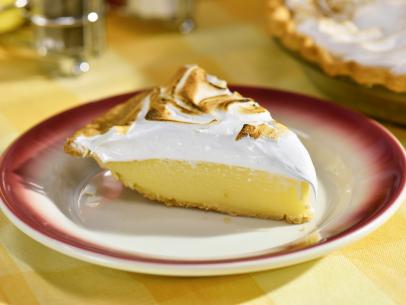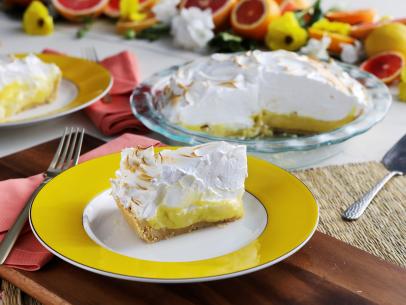
Recipe courtesy of Gale Gand
Lemon Meringue Pie
Getting reviews...
- Total: 2 hr 10 min
- Prep: 1 hr
- Cook: 1 hr 10 min
- Total: 2 hr 10 min
- Prep: 1 hr
- Cook: 1 hr 10 min
Ingredients
Plain and Perfect Pie Crust:
Filling:
Meringue:
Directions
- Plain and Perfect Pie Crust: In a mixer fitted with a paddle attachment (or using a hand mixer), mix the flour, salt, and sugar for 1 minute. Add the butter and mix just until you have a crumbly, sandy mixture. You should still be able to see the pieces of butter. In a small bowl, stir the water and vinegar together. With the mixer running at medium speed, drizzle in the water-vinegar mixture and mix just until a dough forms. You should still see small bits of butter. Turn out onto a work surface, divide the dough in half, and shape into round, flat disks. Wrap separately in plastic wrap and refrigerate at least 30 minutes before using. (Or, refrigerate up to 48 hours or freeze up to 1 month before using. If frozen, let thaw in the refrigerator overnight before rolling out.)
- When the time comes to roll out the dough, let the dough warm up for a few minutes at room temperature. Dust a work surface with just a few tablespoons of flour and keep some extra flour at hand. If you like, you can roll out the dough between 2 sheets of waxed paper (flouring the bottom sheet and the top of the dough before rolling), which makes it much easier to transfer to the pan later on. However, you won't be able to check the progress of the dough as easily. It's entirely up to you. Sprinkle a little flour on top of the dough and start rolling outward from the center with quick, light strokes. Don't worry if the edges split a bit; concentrate on getting a good circle going from the center. Lift up and rotate the dough 1/4 turn every minute or so to help ensure even rolling. The dough should feel smooth and soft; some say it should feel like the inside of your forearm. If it gets sticky, sprinkle on a bit more flour, but don't do this more than 2 or 3 times; the dough will absorb too much flour. Instead, put it back in the refrigerator for 15 minutes to firm up the butter. Keep rolling until the circle is at least 2 inches larger than your pan (for example, 11 inches wide for a 9-inch pie pan), or 3 inches larger for deep-dish pies. Set your pie or tart pan nearby. We always use heavy aluminum pans, because glass pans seem to bake the crust too fast. However, we know that the advantage of glass is that you can easily check the color of the crust. Again, it's up to you. Either choice will work. To transfer the crust to the pan, we find it easiest to roll a finished crust up onto the rolling pin, then gently unroll it in the pan. Or, you can fold it gently in quarters, lift it up, position the center point on the center of the pan, and unfold it into the pan. If using waxed paper, peel off the top layer, turn the crust gently into the pan, and peel off the remaining paper. Make sure that the dough is allowed to settle completely into the pan.
- Don't stretch and press the dough into the corners; stretched dough will likely shrink back when you bake it. Instead, lift the edges of the crust to let it settle down into the corners. If the dough tears a bit, don't be concerned; we'll patch it in a minute. Using scissors or a sharp knife, trim the dough to within 3/4-inch of the rim. Use any extra scraps to patch the crust, pressing with your fingers (wet them if necessary) or set aside.
- Working around the rim, turn the crust under itself (not under the rim of the pan) to make a thick edge, pressing it firmly against the pan to reduce shrinkage. To decorate the rim, just press it all around with the back of a fork. For a slightly more advanced look, press the thumb and forefinger of one hand together. Use them to gently push the thick dough rim outward, while pushing inward with the forefinger of the other hand, so that they intersect in a "V" with the dough in between. Repeat all around the rim to make a wavy edge. Chill the finished crust for 20 to 30 minutes before baking the pie.
- Preheat the oven to 375 degrees. Line the inside of the chilled crust with aluminum foil (don't turn it down over the rim, but leave the extra sticking up so that you have something to hold on to). Fill the foil all the way up to the top of the shell with pie weights or dried beans. Bake 25 to 30 minutes, until dry and beginning to turn "blond." Lift the foil and weights out of the shell and bake another 10 to 15 minutes, checking frequently to prevent overbaking, until medium brown.
- Filling: In a saucepot over high heat, combine sugar, cornstarch, flour, salt and water. Bring to a boil and stir until thickened, about 3 minutes. Combine the lemon zest, juice and extract with the yolks. Temper the yolks with the hot sugar mixture. Stir in the butter and strain through a fine mesh strainer if necessary. Put the mixture back over heat and cook for another 3 minutes. Transfer the custard to the pie crust, hot.
- Preheat oven to 350 degrees.
- Pie Crust Courtesy of "Butter Sugar Flour Eggs" by Gale Gand, Rick Tramonto, Julia Moskin, Clarkson N. Potter Publishers, 1999
- Meringue: In a small saucepan over medium-high heat, stir together the sugar and water until the sugar is completely moistened. Cook until the syrup boils. Turn the heat to low. In the bowl of an electric mixer, beat the egg whites until foamy. Add the cream of tartar and beat until stiff peaks form. Bring the sugar syrup to 236 degrees and slowly drizzle the sugar syrup down the side of the mixing bowl into the whites with the motor of the mixer running. Beat the whites for an additional 2 minutes until shiny.
- Top the custard with meringue, when the custard has cooled to room temperature. Seal the edges carefully, and transfer to the oven. Bake until browned, about 10 minutes. Refrigerate until ready to serve.
Looking for Something Else?
Related Pages
- Lemon Cream Meringue Pie Recipe
- Chocolate Meringue Pie Recipe
- Cranberry Meringue Pie Recipe
- Not Your Usual Lemon Meringue Pie Recipe
- Raspberry Meringue Pie Recipe
- The Best Lemon Meringue Pie Recipe
- (New) Old School Lemon Meringue Pie Recipe
- Inverted Lemon Meringue Pie Recipe
- Mile-High Lemon Meringue Pie Recipe
































